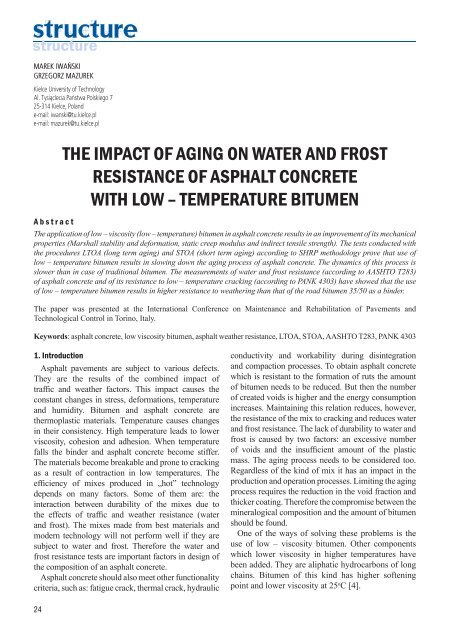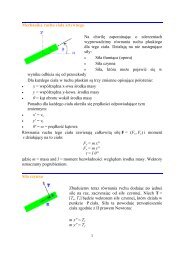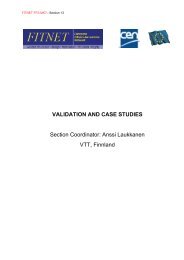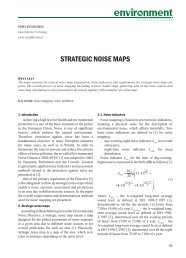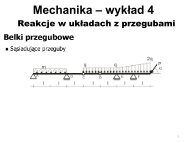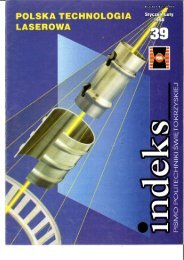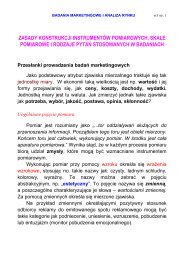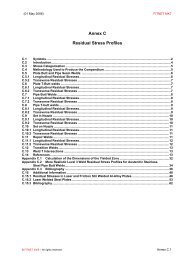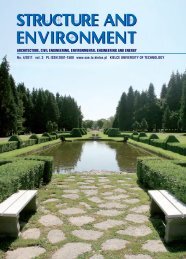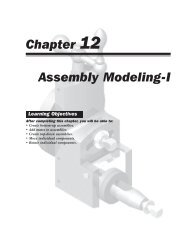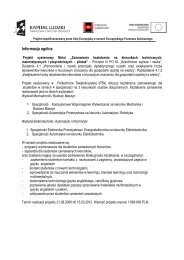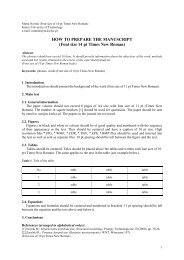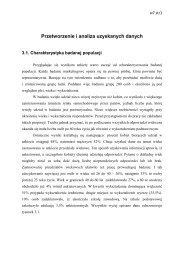Pobierz pełny numer 1/2010 S&E - Structure and Environment - Kielce
Pobierz pełny numer 1/2010 S&E - Structure and Environment - Kielce
Pobierz pełny numer 1/2010 S&E - Structure and Environment - Kielce
- No tags were found...
You also want an ePaper? Increase the reach of your titles
YUMPU automatically turns print PDFs into web optimized ePapers that Google loves.
MAREK IWAŃSKIGRZEGORZ MAZUREK<strong>Kielce</strong> University of TechnologyAl. Tysiąclecia Państwa Polskiego 725-314 <strong>Kielce</strong>, Pol<strong>and</strong>e-mail: iwanski@tu.kielce.ple-mail: mazurek@tu.kielce.plA b s t r a c tTHE IMPACT OF AGING ON WATER AND FROSTRESISTANCE OF ASPHALT CONCRETEWITH LOW – TEMPERATURE BITUMENThe application of low – viscosity (low – temperature) bitumen in asphalt concrete results in an improvement of its mechanicalproperties (Marshall stability <strong>and</strong> deformation, static creep modulus <strong>and</strong> indirect tensile strength). The tests conducted withthe procedures LTOA (long term aging) <strong>and</strong> STOA (short term aging) according to SHRP methodology prove that use oflow – temperature bitumen results in slowing down the aging process of asphalt concrete. The dynamics of this process isslower than in case of traditional bitumen. The measurements of water <strong>and</strong> frost resistance (according to AASHTO T283)of asphalt concrete <strong>and</strong> of its resistance to low – temperature cracking (according to PANK 4303) have showed that the useof low – temperature bitumen results in higher resistance to weathering than that of the road bitumen 35/50 as a binder.The paper was presented at the International Conference on Maintenance <strong>and</strong> Rehabilitation of Pavements <strong>and</strong>Technological Control in Torino, Italy.Keywords: asphalt concrete, low viscosity bitumen, asphalt weather resistance, LTOA, STOA, AASHTO T283, PANK 43031. IntroductionAsphalt pavements are subject to various defects.They are the results of the combined impact oftraffic <strong>and</strong> weather factors. This impact causes theconstant changes in stress, deformations, temperature<strong>and</strong> humidity. Bitumen <strong>and</strong> asphalt concrete arethermoplastic materials. Temperature causes changesin their consistency. High temperature leads to lowerviscosity, cohesion <strong>and</strong> adhesion. When temperaturefalls the binder <strong>and</strong> asphalt concrete become stiffer.The materials become breakable <strong>and</strong> prone to crackingas a result of contraction in low temperatures. Theefficiency of mixes produced in „hot” technologydepends on many factors. Some of them are: theinteraction between durability of the mixes due tothe effects of traffic <strong>and</strong> weather resistance (water<strong>and</strong> frost). The mixes made from best materials <strong>and</strong>modern technology will not perform well if they aresubject to water <strong>and</strong> frost. Therefore the water <strong>and</strong>frost resistance tests are important factors in design ofthe composition of an asphalt concrete.Asphalt concrete should also meet other functionalitycriteria, such as: fatigue crack, thermal crack, hydraulicconductivity <strong>and</strong> workability during disintegration<strong>and</strong> compaction processes. To obtain asphalt concretewhich is resistant to the formation of ruts the amountof bitumen needs to be reduced. But then the numberof created voids is higher <strong>and</strong> the energy consumptionincreases. Maintaining this relation reduces, however,the resistance of the mix to cracking <strong>and</strong> reduces water<strong>and</strong> frost resistance. The lack of durability to water <strong>and</strong>frost is caused by two factors: an excessive numberof voids <strong>and</strong> the insufficient amount of the plasticmass. The aging process needs to be considered too.Regardless of the kind of mix it has an impact in theproduction <strong>and</strong> operation processes. Limiting the agingprocess requires the reduction in the void fraction <strong>and</strong>thicker coating. Therefore the compromise between themineralogical composition <strong>and</strong> the amount of bitumenshould be found.One of the ways of solving these problems is theuse of low – viscosity bitumen. Other componentswhich lower viscosity in higher temperatures havebeen added. They are aliphatic hydrocarbons of longchains. Bitumen of this kind has higher softeningpoint <strong>and</strong> lower viscosity at 25 o C [4].24


